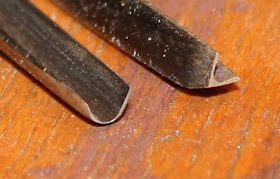 |
| Bent V gouge and straight fluting gouge blanks, both are 4,5mm |
 |
| The grinding stones pose the biggest challenge; their profiles leave a lot to be desired because they do not follow the outside edges very well, |
 |
| An assortment of oil stones and slip stones used to sharpen and shape the gouges |
I learned a very useful sharpening technique from Chis Storb, who works as the furniture conservator for the Philadelphia Museum of Art. He grinds the heel of the V gouge back quite a bit so that there is not so much metal trying to jam itself into the cut which the tool is making. It makes a huge difference. Below is one that I have not gotten around to re-sharpening that way, and the new gouge which I just did, using this method.
 |
| "Out of the box" bevel, and a re-ground bevel which lessens the drag caused by too much metal on the heel of the gouge. |
It always amazes me the difference a few extra passes on the strop will make. The gouge marks on the right of the photo below, were done when I thought they were sharp. It did not take long to see that they were not. A few more passes on the inside with a shaped piece of wood charged with oil and rotten stone made all the difference, as can be seen by the gouge marks to the left.
 |
| Testing the gouges on some old white pine. I purposefully used this wood because when it is old and brittle it will tear even if fresh wood would not. My strop is to the left. |
 |
| A chunk of mulberry from the firewood pile will give a nice pair of handles |
 |
| Bringing the handle to shape |



No comments:
Post a Comment